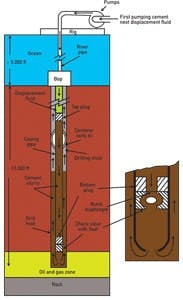Q: During the last two years I read a number of your articles explaining how automation could have prevented the BP oil spill in the Mexican Gulf, but I never fully understood the sealing process they were trying to use in order to temporarily seal the completed oil well when the accident occurred? Can you explain that?
H. Crowney
[email protected]
Read Also: Controls for Drilling Oil and Gas Wells
What makes the control of this process more challenging is that the pipe is 3.5 miles long, and it goes down a well that was drilled into the rock on the bottom of a mile-deep ocean.
In order to make the operation safe, engineers need to do only three things:
- Keep the pressure inside the hole higher than outside it, a situation that required automatic pressure difference (ΔP) control, which BP did not have;
- Make sure that the shut-off valve on the bottom of the ocean, called the blowout preventer (BOP), works. One reason why it might not work can be if it were bent because the 3.5-mile long pipe is not straight (BP should have had a backup BOP, but did not);
- Be ready to quickly move the rig away from the well if 1) and 2) do not work, and methane reaches the rig.
Figure 1. Cement slurry, followed by a top plug and displacement fluid is pumped into the well to seal it.
The figure on the right shows the main components of the well-sealing process. In the 5th edition of my handbook, I will publish the automatic controls required to make this process safe because what BP was doing is not unique at all. Just recently, Shell made the same mistake in the North Sea. When the drilling of the well is done, it is full of drilling mud, which was used to bring up rock fragments during the drilling.Cementing starts by pumping a cement slurry (brown in Figure 1) into the well through the casing pipe. This cement is pumped down behind the "bottom plug," which has a burst diaphragm on its bottom. When the bottom plug reaches the tip of the pipe (detail at the bottom right), the pumped cement breaks the burst diaphragm (rupture disk), and the concrete flows through it, rising in the annulus and displacing the drilling mud (light gray) as it is displacing it and pushing it up and out of the annulus.
Read Also: Improving Oil and Gas Well Safety
When the space between the pipe casing and the wall of the well is filled with cement, the "top plug" is inserted into the casing pipe, and it is pushed down by a displacement fluid (green) that is pumped in behind the top plug. When the top plug reaches the bottom plug, the sealing job is done, and the check valve below the bottom plug prevents flow reversal.
It sounds simple. All that is needed is to control the pump discharge pressure automatically, so that the pressure inside the well is always higher than the pressure of the methane in the rock formation. The BP engineers should have measured the methane pressure in the formation and selected a heavy enough cement mixture to exceed it. As is so often the case, they did not measure either the methane pressure, nor the cement density, because they had instructions to move fast, since the cost of the rental of the rig was $1 million a day. So they provided no automation, no sensors, and made no calculations (automatic or manual); they just picked a quick-setting cement. They did not have automatic pressure difference control either, so the discharge pressure of the cement pump was not raised to keep the cement pressure above that of the methane.
Next, the check valve failed at the tip of the casing pipe, so the methane entered the pipe. Again, there was no status sensor on the check valve, so the operators did not even know that it was stuck open. Furthermore, they did not have a backup check valve either, so the methane started to rise in the casing pipe. Again, there was no flow reversal sensor or methane detector, so the methane reached the blowout preventer (BOP), which did not work either, and also did not have a backup. The reason the BOP did not work was that the engineers "saved" on using the required number of centerers (they used six instead of 21), which was not enough to keep the riser pipe straight, and the bent pipe caused the BOP to get stuck. Therefore, the crew recognized that there was trouble only when they smelled methane on the rig. Even at that time, they did not move the rig away from the blowing well, so people lost their lives. All because of a lack of automation!
Béla Lipták
[email protected]
Read Also: Scraping the Bottom of the Barrel-Part 3
Q: What is the difference between the orifice calculations described by AGA 3 and ISO 5167? For what kind of services should we calculate by AGA 3, and what applications should be calculated using ISO 5167?
Ara Noche
[email protected]
A: AGA3 (aka API MPMS14.3) is specifically for metering of natural gas. ISO 5167 is generic for liquids or gases. For natural gas, the question to be asked is "what does the sales contract call for?" They both give similar answers, but not exactly the same ones.
Ian H. Gibson
[email protected]
A: The recommended services for AGA 3 include applications where orifice plate-based flow measurement is used for natural gas or other hydrocarbon gases. ISO-5167-2 is recommended for liquid, air, vapor or other non-hydrocarbon gases. ISO-5167 could be used for hydrocarbon gases where custody transfer calculations are not required.
AGA 3 is intended for calculation of natural gas and other hydrocarbon gas flows through orifice plates, or considering a more detailed set of variables, including the gas expansibility factor, the gas relative density that depends on the molar composition of the gas, gas compressibility factors, etc. ISO 5167-2 developed a calculation for fluid in general that considers the expansibility factors for air, steam and natural gas. ISO-5167-2 can also be used for all gases, liquid and vapors fluids.
Francisco Alcalá
[email protected]
A: My experience is that the end user decides which of the several standards to use. It is typically an industry-specific thing. In general, the gas industry uses AGA. The ISO equations have been nearly the same. (And I could be out of date here. Periodically, the different organizations talk about reconciling any differences). If there is a purchase or sales contract involved, you need to look at that.
In fact, AGA, ISO and ASME equations are all so close in their results that those differences are normally much smaller than the uncertainities caused by non-ideal installations. For example, a few years ago there was much discussion about which gas expansion factor equation to use. I ran the calculation and did a 3D plot of the differences, and it showed that, yes, there were differences, but they were so small that they made no real difference.
So ask the client. If they care, then use whatever program is available, but I suggest that you document what you did. You do want to use current standards, not old ones.
Cullen Langford
[email protected]






